Dance Events for the 1984 Olympic Arts Festival
Sharon Took-Zozaya writes about her work as an Assistant to the Executive Director of the Olympics Dance Festival.
1984 Olympic Arts Festival Dance Component
(Hereafter referred to as Olympics Dance Festival)
The citywide arts festival which preceded the Los Angeles Summer Olympic Games in 1984 was the first large scale festival of its kind in LA. It ran from June 2 through August 12, and ranged from US premieres by innovative international companies, to performances by well-known local professional and community groups. According to Aljean Harmetz of The New York Times, “It provided more than 400 performances by 145 theater, dance and music companies, representing every continent and 18 countries.” (http://www.nytimes.com/1984/06/02/theater/olympic-arts-festival-opens-in-la.html)
Bella Lewitzky was Artistic Director of Olympic Dance Festival and Darlene Neel, Lewitzky Dance Company Manager, was the Dance Festival’s Executive Director. That summer I’d just complete several years of chairing the Scripps College Program and was on my way to graduate school at ASU. I was hired to be Assistant to the Executive Director, primarily to handle press and public relations.
These were exciting and hectic times! We managed several venues all over the city from our Holiday Inn office next to the Pasadena Civic Auditorium, the primary dance venue. Other major dance venues were the Asian Pacific Cultural Center in downtown LA and UCLA’s Schoenberg Hall on the Westwood campus.
The Olympic Arts Festival opened at the 3,000 seat Pasadena Civic Auditorium with the American debut of the highly acclaimed avant-garde Pina Bausch Wuppertaler Tanztheater from West Germany. Three different programs of Bausch ‘s work were presented over six nights, including works such as: 1980, Café Muller, Bluebeard and Rite of Spring, excerpts of which are included in the recent film ‘Pina’. Audiences were both shocked and delighted.
Featured companies at the Pasadena Civic Auditorium, the main location where I was based, also included such diverse groups as Les Ballets Africains du Guinea from Africa, London Contemporary Dance Theatre, the Royal Winnipeg Ballet, and butoh– based Sankaijuku from Japan and the Korean National Dance Company. The world of dance came to us and I saw them all multiple times.
Performances at the Asian Pacific Cultural Center also represented wide-ranging dance styles and performers. For me, notable highlights were a modern revival of tap dance by original members of the Copasetics, and the LA based Jazz Tap Ensemble. Perhaps others can add the names of additional groups who performed here and in the Asian Pacific Dance Festival curated by Judy Mitoma, which included indoor and outdoor performances.
Overall, the Olympic Dance Festival was a highly successful and fulfilling ten weeks. Los Angeles audiences celebrated the rich diversity and expressive power of dance as an art form presented on an equal basis with the other arts, in a way that has rarely, if ever, been matched. As my colleagues and I watched the opening ceremony for the Olympic Games following the festival, I felt as though I’d had a series of deliciously satisfying gourmet meals. It was time to prepare to go off to graduate school full of inspiration.
If you have more information about the following, adding your comments at the end of the article would be appreciated:
- Which companies performed at Schoenberg Hall?
- Was The Sixth Dance Kaleidoscope June 22-29 at the Anson Ford Theatre officially part of the Olympic Arts Festival? I presented a piece in Dance Kaleidoscope that year, but don’t remember handling any publicity for it as part of the Olympic Dance Festival.
© Copyright 2012 Sharon Took-Zozaya All rights reserved




